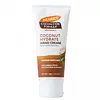What's inside
What's inside
 Key Ingredients
Key Ingredients

No key ingredients
 Benefits
Benefits

 Concerns
Concerns

 Ingredients Side-by-side
Ingredients Side-by-side

Water
Skin ConditioningCocos Nucifera Fruit Extract
EmollientGlycerin
HumectantCocos Nucifera Oil
MaskingCetearyl Alcohol
EmollientGlyceryl Stearate
EmollientHydrogenated Vegetable Oil
EmollientGlycine Soja Oil
EmollientDi-PPG-3 Myristyl Ether Adipate
EmollientTheobroma Cacao Seed Butter
EmollientDimethicone
EmollientPEG-100 Stearate
Tocopherol
AntioxidantTocopheryl Acetate
AntioxidantCoffea Robusta Seed Extract
Skin ConditioningCocos Nucifera Water
MaskingGardenia Taitensis Flower Extract
Skin ConditioningPrunus Amygdalus Dulcis Oil
Skin ConditioningMacadamia Ternifolia Seed Oil
EmollientLeuconostoc/Radish Root Ferment Filtrate
AntimicrobialEthylhexylglycerin
Skin ConditioningTetrasodium EDTA
Sodium Polyacrylate
AbsorbentIsopropyl Myristate
EmollientPhenoxyethanol
PreservativeParfum
MaskingBenzyl Benzoate
AntimicrobialCoumarin
PerfumingBenzyl Alcohol
PerfumingWater, Cocos Nucifera Fruit Extract, Glycerin, Cocos Nucifera Oil, Cetearyl Alcohol, Glyceryl Stearate, Hydrogenated Vegetable Oil, Glycine Soja Oil, Di-PPG-3 Myristyl Ether Adipate, Theobroma Cacao Seed Butter, Dimethicone, PEG-100 Stearate, Tocopherol, Tocopheryl Acetate, Coffea Robusta Seed Extract, Cocos Nucifera Water, Gardenia Taitensis Flower Extract, Prunus Amygdalus Dulcis Oil, Macadamia Ternifolia Seed Oil, Leuconostoc/Radish Root Ferment Filtrate, Ethylhexylglycerin, Tetrasodium EDTA, Sodium Polyacrylate, Isopropyl Myristate, Phenoxyethanol, Parfum, Benzyl Benzoate, Coumarin, Benzyl Alcohol
 Reviews
Reviews

Ingredients Explained
These ingredients are found in both products.
Ingredients higher up in an ingredient list are typically present in a larger amount.
Cetearyl alcohol is a mixture of two fatty alcohols: cetyl alcohol and stearyl alcohol. It is mainly used as an emulsifier. Emulsifiers help prevent the separation of oils and products. Due to its composition, it can also be used to thicken a product or help create foam.
Cetearyl alcohol is an emollient. Emollients help soothe and hydrate the skin by trapping moisture.
Studies show Cetearyl alcohol is non-toxic and non-irritating. The FDA allows products labeled "alcohol-free" to have fatty alcohols.
This ingredient is usually derived from plant oils such as palm, vegetable, or coconut oils. There is debate on whether this ingredient will cause acne.
Due to the fatty acid base, this ingredient may not be Malassezia folliculitis safe.
Learn more about Cetearyl AlcoholEthylhexylglycerin (we can't pronounce this either) is commonly used as a preservative and skin softener. It is derived from glyceryl.
You might see Ethylhexylglycerin often paired with other preservatives such as phenoxyethanol. Ethylhexylglycerin has been found to increase the effectiveness of these other preservatives.
Glycerin is already naturally found in your skin. It helps moisturize and protect your skin.
A study from 2016 found glycerin to be more effective as a humectant than AHAs and hyaluronic acid.
As a humectant, it helps the skin stay hydrated by pulling moisture to your skin. The low molecular weight of glycerin allows it to pull moisture into the deeper layers of your skin.
Hydrated skin improves your skin barrier; Your skin barrier helps protect against irritants and bacteria.
Glycerin has also been found to have antimicrobial and antiviral properties. Due to these properties, glycerin is often used in wound and burn treatments.
In cosmetics, glycerin is usually derived from plants such as soybean or palm. However, it can also be sourced from animals, such as tallow or animal fat.
This ingredient is organic, colorless, odorless, and non-toxic.
Glycerin is the name for this ingredient in American English. British English uses Glycerol/Glycerine.
Learn more about GlycerinPhenoxyethanol is a preservative that has germicide, antimicrobial, and aromatic properties. Studies show that phenoxyethanol can prevent microbial growth. By itself, it has a scent that is similar to that of a rose.
It's often used in formulations along with Caprylyl Glycol to preserve the shelf life of products.
Water. It's the most common cosmetic ingredient of all. You'll usually see it at the top of ingredient lists, meaning that it makes up the largest part of the product.
So why is it so popular? Water most often acts as a solvent - this means that it helps dissolve other ingredients into the formulation.
You'll also recognize water as that liquid we all need to stay alive. If you see this, drink a glass of water. Stay hydrated!
Learn more about Water